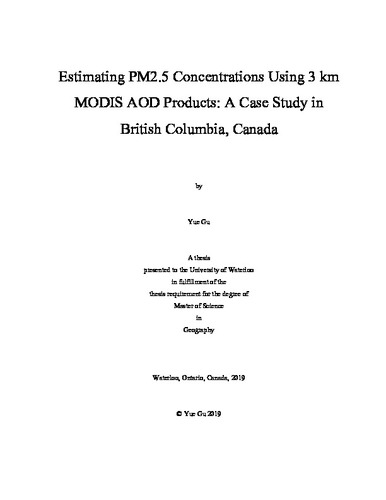| dc.description.abstract | PM2.5 refers to fine particles with diameters smaller than 2.5 μm. The rising level of PM2.5 reveals adverse effects on climate change, economic losses, international conflicts, and public health. Exposure to the high level of PM2.5 would increase the risk of premature death, especially for people with weak immune systems, such as children and elder people. The main sources of PM2.5 include combustion of biomass, vehicle and industrial emissions, and wildfire smoke. British Columbia (BC), Canada, with a land area of 944,735 km2 and 27 regional districts, experienced its record-breaking wildfire season in 2017. However, due to the uneven distribution of PM2.5 ground monitoring stations in BC, PM2.5 concentrations in the rural area are difficult to retrieve. Remote sensing techniques and geographical information systems (GIS) could be used as supplementary tools to estimate PM2.5 concentrations. Aerosol Optical Depth (AOD) has been proven to have a strong correlation with PM2.5. Moderate Resolution Imaging Spectroradiometer (MODIS) provides AOD products in both 3 km and 10 km resolutions. The 3 km MODIS AOD products were released in 2013, and have been widely used to estimate PM2.5 concentrations in several studies.
This study adopted the 3 km Aqua MODIS AOD products to estimate PM2.5 concentrations in BC in the year of 2017 by combining ground station measurements, meteorological and supplementary data. MODIS AOD products were validated with ground-level AErosol RObotic NETwork (AERONET) AOD data. The Multiple Linear Regression (MLR) model, Geographically Weighted Regression (GWR) model, and a novel theoretical model were then conducted to estimate PM2.5 concentrations by integrating MODIS AOD products, ground-level PM2.5 concentrations, meteorological and supplementary data. After comparing the performance of the three models, the GWR model was used to generate annual, seasonal, and monthly spatial distribution maps of PM2.5. The application feasibility of MODIS AOD products in predicting PM2.5 was also examined.
The validation results showed that there was a strong correlation between the MODIS AOD and the AERONET AOD. The GWR model had the best prediction performance, while the MLR generated the worst prediction results. After analyzing the spatial distribution maps of PM2.5 with ground-level PM2.5 distribution maps, it could be concluded that the PM2.5 concentrations estimated by the GWR model almost follow the same trend as ground station measured PM2.5. In addition, PM2.5 concentrations were the highest in summer and August based on the estimation results of seasonal and monthly GWR models. It indicated that the application feasibility of MODIS AOD products in predicting PM2.5 concentrations during BC’s wildfire season was high. | en |

